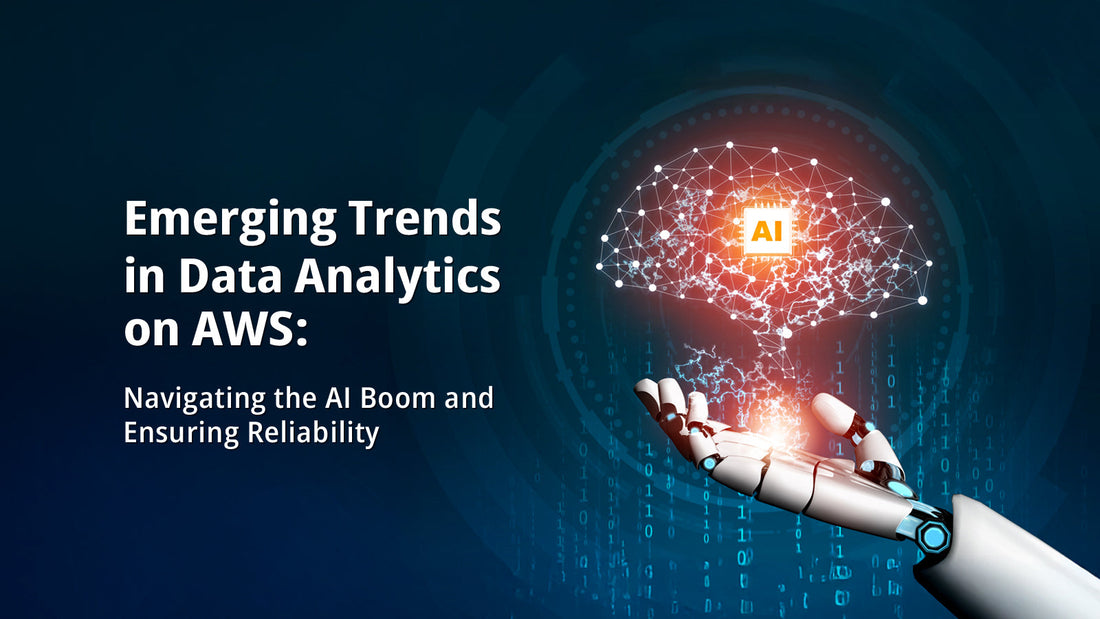
Emerging Trends in Data Analytics on AWS: Navigating the AI Boom and Ensuring Reliability
Share
By - Joe Conley
As the author of Advanced Data Analytics with AWS, I'm excited to share insights into the rapidly evolving world of cloud-based data analytics. My book explores everything from getting started with AWS services to advanced analysis and future possibilities, drawing on real-world applications to help readers harness data for better decision-making. Since I’ve written this book, there’s been an important trend reshaping the field of data analytics: the integration of artificial intelligence (AI) and machine learning (ML) into data analytics workflows. This has critical implications for reliability and speaks to my book's emphasis on practical, trustworthy analytics in an AWS environment.
Let's start with the trends
Based on the latest industry shifts, AI is no longer just a buzzword; it's the engine driving data analytics forward. Industry leaders are investing billions in AI, and new models and frameworks are being released weekly. One of these leaders, AWS, has been at the forefront. Services like Amazon Bedrock enable seamless access to generative AI models for tasks such as natural language processing and predictive analytics. Organizations are increasingly using Bedrock to generate insights from unstructured data, like customer reviews and social media feeds, integrating it with Amazon S3 data lakes for scalable storage. Another hot trend is zero-ETL (extract, transform, load) integrations, exemplified by updates to Amazon Redshift and Athena, which allow analysts to query data directly without complex pipelines. This serverless approach, often orchestrated via AWS Lambda (which my infrastructure relies on for executing SQL queries), reduces time-to-insight and costs.
Real-time analytics is another surge area, powered by Amazon Kinesis and enhanced by ML models in Amazon SageMaker. Imagine processing streaming data from IoT devices or e-commerce transactions to detect anomalies instantly— this is becoming standard for industries like finance and healthcare. Sustainability is also gaining traction; AWS's Carbon Footprint tools now incorporate analytics to optimize energy use in data processing, aligning with global green computing initiatives. Looking ahead, data mesh architectures are trending, decentralizing data ownership while using AWS Glue for governance, enabling teams to treat data as a product.
As AI permeates data analytics, a critical issue emerges: reliability. Recent events highlight the risks when AI is used irresponsibly. For example, Springer Nature retracted a book on machine learning in August 2025 due to fake citations generated by large language models like ChatGPT. The publisher identified 25 unverifiable references, undermining the book's credibility. This isn't an isolated case; it's part of a broader trend where AI tools produce plausible but inaccurate content, from fabricated data sources to hallucinatory insights. In data analytics, this could translate to flawed models or biased predictions if not vetted properly.
From my perspective as an expert who's built analytics pipelines on AWS, this underscores the need for strong human oversight and checks and balances. Over my career I’ve learned that technology alone isn't enough: context matters (especially for LLMs). For example, when using SageMaker for ML models, always validate datasets with tools like AWS DataBrew to catch biases early. A best practice I recommend is implementing "human-in-the-loop" workflows: use AI for initial data exploration via QuickSight Q (AWS's natural language querying tool), but have experts review outputs. This mirrors lessons from my book, where I emphasize secure, orchestrated processes using AWS Step Functions to avoid errors in data processing.
Another tip: Leverage AWS's security features, like Macie for sensitive data detection, to ensure compliance amid AI's growth. For those starting out, begin with simple how-tos: Set up a Lambda function to run SQL queries on Athena for quick descriptive analytics, then scale to AI with Bedrock for advanced forecasting. Avoid over-reliance on generative AI for content creation-whether in reports or books-by cross-referencing with reliable sources. The retraction case shows how fake citations can erode trust; in analytics, similar lapses could lead to misguided business decisions.
In conclusion, the future of data analytics (specifically on AWS) is bright, fueled by AI innovations that make insights faster and more accessible. As trends like generative AI accelerate, we must prioritize reliability to avoid pitfalls like those seen in recent publishing scandals. My book provides a roadmap for navigating these waters, from collecting data with Kinesis to visualizing trends in QuickSight. If you're keen to dive deeper, check out Advanced Data Analytics with AWS!
